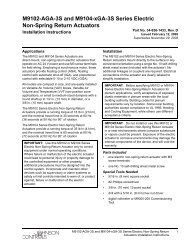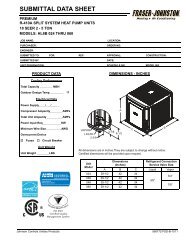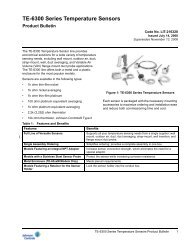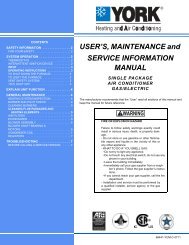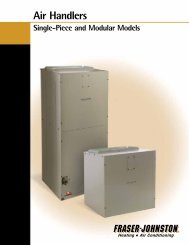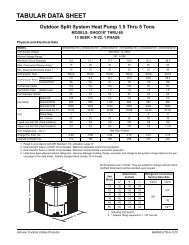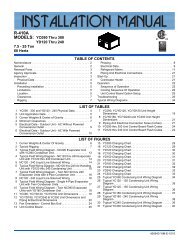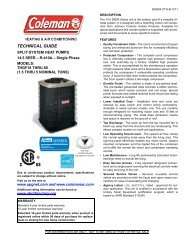analog to digital converter . . . . . . . . . . . . . . . 4 - UPGNet
analog to digital converter . . . . . . . . . . . . . . . 4 - UPGNet
analog to digital converter . . . . . . . . . . . . . . . 4 - UPGNet
You also want an ePaper? Increase the reach of your titles
YUMPU automatically turns print PDFs into web optimized ePapers that Google loves.
351579-YTS-B-0608for economizer loading arises in Communicating ZoningSystem applications (“VVT” systems) using supply air bypasswhen heating load in the zones is low and a large amount of hotsupply air is bypassed back in<strong>to</strong> return and mixed airtemperature is very high. Economizer loading may also beneeded when supply air flow across the heat exchanger islower than expected (e.g. wrong setting of fan speed, pluggedair filters). A secondary benefit of economizer loading is animprovement in comfort as the supply air temperature is morestable and cycling of the unit is minimized.The economizer loading option in heating is not implemented inVAV applications as these do not use supply air bypass and (incase of using a zone thermostat) run all heating stages duringheating (economizer loading applies <strong>to</strong> only the 1 st heating stage).The economizer loading minimizes cycling of heating stage #1and makes a trade-off between energy and the benefitsdescribed above.The Economizer Loading in heating option requires a SATsensor that can sense SAT in heating mode (a sensor placeddownstream of the heating stages). Such a sensor is providedonly as a field-installed accessory, on units equipped withheating stages. The SAT sensor that is fac<strong>to</strong>ry-installed can beused for cooling mode only. If a field-installed sensor is added, itwill replace the fac<strong>to</strong>ry-installed one and will then be usable forboth heating and cooling modes.The loading is done by the similar control algorithm as used inthe normal economizer operation. The algorithm is activated <strong>to</strong>do this function in following conditions:• Heating mode• The programmable option “Economizer Loading <strong>to</strong> ControlSAT” is ON• Only heating stage #1 is runningThe PI control algorithm in this case has a capability <strong>to</strong>au<strong>to</strong>matically change from direct <strong>to</strong> reverse acting in response<strong>to</strong> difference between OAT and RAT. When OAT is less thanRAT the algorithm is direct acting, when OAT is greater thanRAT the algorithm is reverse acting.This way, the “loading” of the heating stage is correctly donewith return, or outdoor air, as appropriate, and there is no need<strong>to</strong> activate this “loading” function only in some specific range ofoutdoor air temperatures (e.g. OAT > programmed first heatingstage trip point minus 50 °F).NOTE:In this case, the provision for direct vs. reverse actingswitching is not essential feature of the control algorithmand the algorithm could be implemented as direct actingonly in order <strong>to</strong> simplify implementation and save codespace. The situation when economizer loading in heatingis required while OAT greater than RAT is unlikely and ifit should occur, the difference between OAT and RAT isnegligible in comparison <strong>to</strong> the SAT control setpoint. TheEconomizer Loading function in heating controls SAT <strong>to</strong>a fixed temperature deadband of programmed “EconomizerLoading Setpoint in Heating” and 5 °F below thissetpoint (the setpoint is programmable between 100 °F -195 °F, default is 160 °F).In units that use hydronic heat, the Economizer Loading functionmay be enabled in order <strong>to</strong> be used for cooling (the on/offprogramming choice for this function is common <strong>to</strong> both coolingand heating). In this case, it is important <strong>to</strong> ensure that theprogrammed value of the “Economizer Loading Setpoint inHeating” is set higher than the value of “Hydronic Heat First StageSetpoint”. That, in normal conditions, assures that the EconomizerLoading function in heating is effectively disabled and theeconomizer is closed <strong>to</strong> its minimum position during heating.VAVWhen is the Economizer operation used? If the roof<strong>to</strong>p unit isequipped with an economizer and free cooling is available thenthe Economizer Operation as specified in this section is used inthe following operation modes:VAV cooling (except the programmed Economizer First StageSetpoint and Economizer Second Stage Setpoint are replacedby the programmed VAV Upper Cooling SAT Setpoint and VAVLower Cooling SAT Setpoint)DEMAND VENTILATIONDemand Ventilation Operation control mode is self-configuringfor the use of an Indoor Air Quality (IAQ) sensor - it willau<strong>to</strong>matically detect that an IAQ sensor is connected and use itany time the IAQ sensor input indicates an IAQ level of 200ppm, or higher.NOTE:Due <strong>to</strong> the self-configuration operation, an error due <strong>to</strong>IAQ sensor failure can be indicated only in case theIAQ sensor fails during normal controller operation. Ifthe IAQ sensor fails, or is removed / disconnected duringa power-off condition (e.g. during servicing of theunit while the control is not powered), the control will,on power up, self configure without the IAQ sensorand no error indication is provided.When the IAQ sensor is detected as available, the control willuse the Demand Ventilation Setpoint <strong>to</strong> control the IAQ levels inthe building by modulating the Economizer more open.The Demand Ventilation will operate in units equipped with anEconomizer (Economizer option is turned ON) any time thecontrol is in Occupied mode. The Demand Ventilation Operationis applicable in heating, or cooling mode, and will modulate theEconomizer damper more open, if necessary, from itsprogrammed minimum position (in heating, or in cooling wheneconomizer is not "suitable"), or from its modulated positiondetermined as defined in the Economizer Operation section (incooling, when economizer is "suitable").An appropriate control algorithm is used <strong>to</strong> accomplish thiscontrol. Preferably, this algorithm is a "step-and-wait" type, withthe step size calculated as a function of offset between theDemand Ventilation Setpoint and the current IAQ level, and witha fixed "wait", or sampling time. This algorithm is activatedwhenever the IAQ level exceeds the setpoint and will overridethe economizer position more open, as needed, up <strong>to</strong> a preJohnson Controls Unitary Products 39



